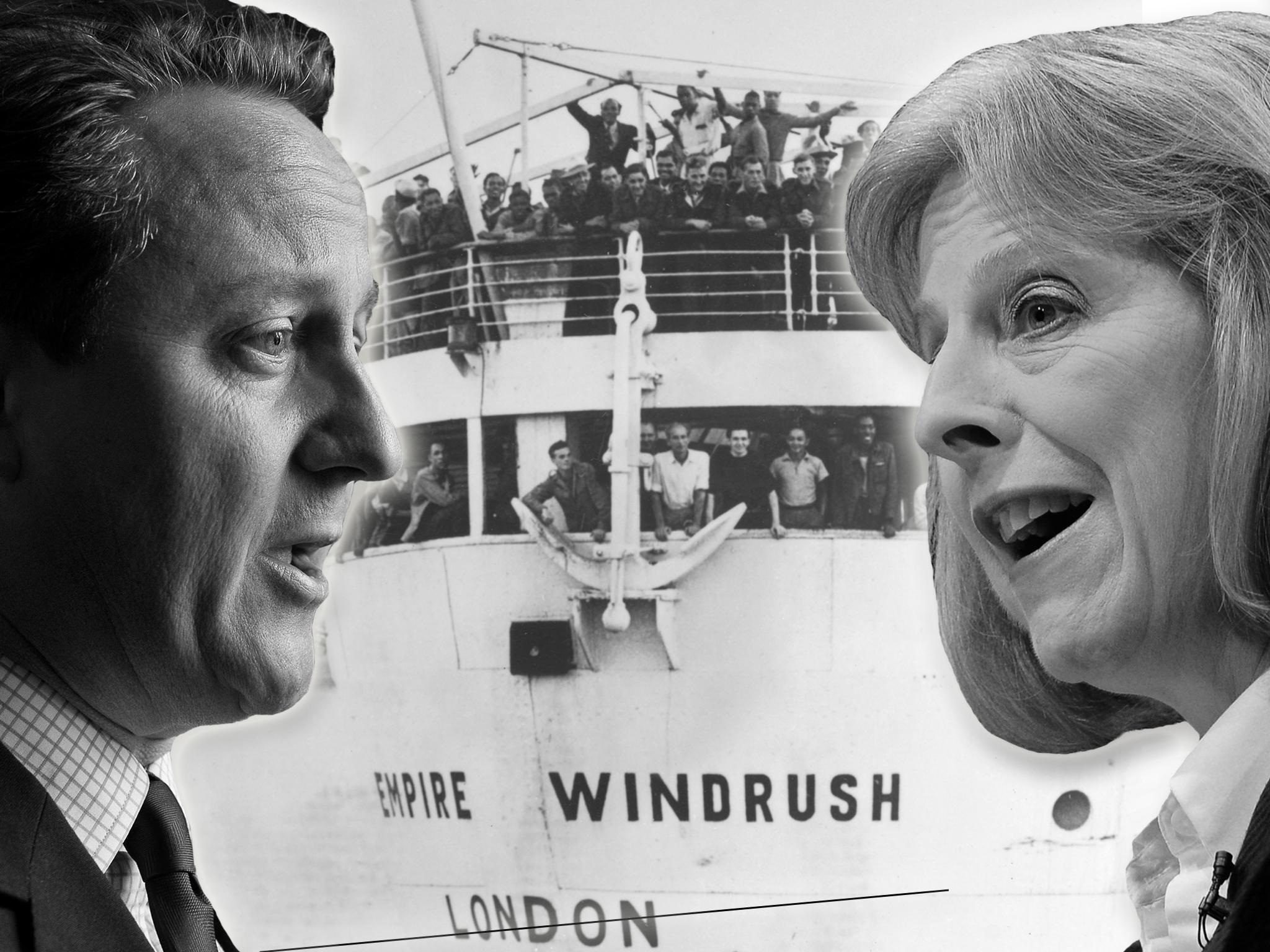David Cameron: The prime mover behind Britain’s hostile environment, who escaped the blame
While Theresa May is seen as the sole architect behind the ‘dehumanising’ policy, ex-ministers detail how the coalition prime minister was its driving force


Your support helps us to tell the story
From reproductive rights to climate change to Big Tech, The Independent is on the ground when the story is developing. Whether it's investigating the financials of Elon Musk's pro-Trump PAC or producing our latest documentary, 'The A Word', which shines a light on the American women fighting for reproductive rights, we know how important it is to parse out the facts from the messaging.
At such a critical moment in US history, we need reporters on the ground. Your donation allows us to keep sending journalists to speak to both sides of the story.
The Independent is trusted by Americans across the entire political spectrum. And unlike many other quality news outlets, we choose not to lock Americans out of our reporting and analysis with paywalls. We believe quality journalism should be available to everyone, paid for by those who can afford it.
Your support makes all the difference.It was Theresa May who, as home secretary, declared in 2012 that her aim was to “create, here in Britain, a really hostile environment for illegal immigrants”. It was May’s department that sent out vans with messages telling undocumented migrants to “go home” emblazoned across them.
And it was under her premiership that the Windrush scandal erupted, with thousands of Commonwealth citizens wrongly targeted for deportation, leaving seriously ill people too afraid to access proper healthcare in case it led to their removal from the UK.
But while the most notorious examples of the hostile environment were overseen by May, the prime mover behind the policy – according to ministers and officials from the coalition government – was her predecessor in No 10, David Cameron.
It marked a sea change in immigration policy in 2010 when Cameron pledged to bring annual net migration down to the tens of thousands. Such a drastic reduction – on a crude scale that took no account of where migrants were from, why they had come to Britain or what their skills were – would take a dramatic hardening of Britain’s rules on immigration.
Tory heavyweight Eric Pickles was far from a shrinking violet, memorably claiming householders who left wheelie bins in the street “should be flogged”. But during his time as local government secretary in the coalition, there was one idea floated by his boss in 2013 that caused him to quail at its sheer unfairness and impracticality: making landlords check the immigration status of prospective tenants before letting out homes to them.
“I thought it was ill-conceived – utterly wrong,” says Pickles. “If you’re a landlord, how the heck do you know what various documents look like? And wouldn’t you say to yourself, ‘Well heck look, this person’s got dark skin or a funny sounding surname, the safest thing is not to rent to them?’”
When Pickles voiced his opposition to the proposal at a ministerial meeting, as he sat alongside deputy prime minister Nick Clegg, Jeremy Hunt and Oliver Letwin, Cameron blew up. Ministers remember the meeting “collapsing into chaos” as the prime minister slammed his red folder on the table and stormed out of the room before they had finished the agenda. It was the first and only time Pickles felt the wrath of his boss directed against him so vociferously. “I had a really good relationship with David, and we continued to have a good relationship,” he says. “But he got up and walked out of the meeting. He was so angry with me.”
What many ministers had failed to realise was that the policy Cameron was pushing through, which he finally managed to implement in the final year of his leadership through the controversial Right to Rent scheme, was an early sign of a much bigger shift in the way the government dealt with immigration. Over the next few years, under the banner of this bid to create a “hostile environment”, policies were brought in that placed the onus on ordinary people – such as landlords, doctors and employers – to check the immigration status of anyone trying to access their services, and block anyone who couldn’t provide the relevant documents.
This catch-all strategy is what caused the Windrush scandal, which led to Amber Rudd’s resignation in April 2018. People with the right to be in Britain were denied life-saving medical treatment and prevented from working or accessing benefits, plunging them into destitution. In the worst cases, men and women who had lived in the UK for decades suddenly found themselves detained in immigration centres and forcibly removed to countries they had not been to since they were young children – all in error.
The early thinking behind the hostile environment was encapsulated by the creation of a ministerial group in 2012 designed “on the explicit instructions of the prime minister”. Initially dubbed the “hostile environment working group”, its very purpose was to “bear down on immigration”. It brought together ministers from 12 government departments in order to investigate how they could “enforce” the immigration system and “toughen it up”. Following complaints from Liberal Democrats about the name, the group was re-titled “Matbaps” – migrants’ access to benefits and public services – a “bland and boring title on something quite dehumanising”, as one former Lib Dem adviser puts it.
While the working group started off as a fairly low-level operation, it quickly became a central plank in the prime minister’s agenda. According to David Laws, who as schools minister was part of the group, May focused on the policy implementation, while Cameron propelled the politics, seeing it as “red meat” to feed to the right of the Tory party. He recalls that after just one meeting at minister of state level, Cameron “pounced on” the group and turned it into a cabinet committee which met in No 10. “He was thinking of it very much in terms of being tough on immigration, knocking down the Ukip vote, showing that we were taking decisive action, grabbing newspaper headlines,” says Laws. “He desperately wanted to be seen to be doing something on immigration, and he wanted this to be a big initiative that he was going to drive forward.”
One of the few MPs to raise concerns about the hostile environment early on was Lib Dem Sarah Teather, who was minister for children and families from 2010 to 2012. She remembers the first warning sign was a proposal to introduce an income threshold for people applying for spousal visas to join their loved ones in the UK, with figures floated as high as £40,000 – leaving her outraged. “It seemed so absurd at the time that we thought it was just Conservatives being out of touch,” she says, adding: “But actually it was a sign of something else.”
Teather became even more horrified when ministers began discussing the idea of refusing school places for the children of undocumented migrants as a way of encouraging more to leave and dissuade others from coming to the UK, fearing it would “erode” the right to education. The MP was equally as appalled by a proposal for the school pupil database to be used by the Home Office to track down illegal over-stayers – an idea that was later made policy, but halted following intense pressure from campaigners.
When Teather was dropped from government in a 2012 reshuffle, she decided to voice her concerns in public, telling the Guardian she was “appalled” by the creation of the working group, warning that this “new consensus” had “stifled” the debate on immigration, and that she found it “truly terrifying”. She hoped that if she exposed what was happening it would “wake people up” and prompt an “uprising of shock and horror” at the government’s increasingly aggressive approach to cutting down immigration.
But there was no such backlash. “There was a brief gasp of shock, a ripple, and then things just moved on,” says Teather, recalling how just a week after the interview was published, the controversial “Go Home” vans were driven through her constituency. “I was hoping that putting it into the public domain would help flush it out. But it was like shouting into a vacuum.”
So the ramping up of the hostile environment continued, and this is where Ms May, as home secretary, made clear her staunch devotion to the cause. Lib Dems who worked under her in the Home Office remember a department that was “geared towards reducing immigration”, with a team of civil servants who were “willing lackeys” voicing little or no resistance to this aim. And if they did, they were “shunted off somewhere else”.
Norman Baker, who was a Home Office minister for a year from October 2013, remembers: “The immigration civil servants were of the capital T and F ‘true faith’. They were zealots. They saw it was their job to come back almost every week with some new tweak which would make immigration more difficult.” When it came to trying to voice his own concerns, Baker says May deliberately tried to keep his party out of the loop. “She didn’t let me do anything apart from my portfolio,” he recalls. “Everything was a battle with her, and you can only fight so many battles at once. There’s only so much you can do when you’ve got somebody like that.”
This frustration was shared by the leader of the Lib Dems, according to Matt Sanders, former adviser to Clegg, who describes the deputy prime minister’s relationship with May as “really, really difficult”. He recalls: “She wouldn’t negotiate. She just could not do it. We would have really frustrating meetings where Nick would say, ‘I’m worried about “X”’ and she would just restate her position. You would go through a whole meeting like that where she could not go off script.”
Teather, who tried to reason with May on numerous occasions before she was sacked from government, remembers the home secretary “micromanaging [the department] within an inch of its life”, refusing to let anybody under her wield any power. After several attempts to negotiate with her on her campaign to end child detention – which was ultimately successful – Teather gave up on trying to engage in discussions with May. “It was clearly pointless,” she says. “She was so in control of that department, and anyone who worked under her was given very little freedom – totally disempowered.”
But while May’s role in the disasters that stemmed from the hostile environment is undisputable, those in government at the time are keen to stress the fact that she was acting on the instructions of her boss, who they say has “largely dodged the blame”. Laws, who vetoed the plan to force schools to check immigrant status of pupils, says that while May was in charge of the “practicalities”, Cameron was, “ironically, more of a driving force” who wanted to “bulldoze” the policies through. “He was the one who desperately wanted to be seen to be doing something on immigration,” Laws recalls. ”He was leading the controversial stuff, she wasn’t.”
Almost 10 years on from the pledge to cut net migration to the tens of thousands – a policy that remained on the Tory manifesto at the last election – the hostile environment has caused untold damage to thousands of families in Britain. Repeated Home Office failings mean that many are still suffering. And whatever Cameron’s intentions, the warnings of what would happen were there at the start, from around his cabinet table.
Join our commenting forum
Join thought-provoking conversations, follow other Independent readers and see their replies
Comments